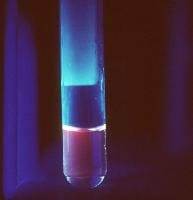NICE IDEA:
--most antifreeze (which contains ethylene glycol) has fluorescein added to it
--fluorescein should light up with a Wood's lamp (=blacklight = UV)
--can you light up a patient's face (to see if they drank some) and/or urine (to see if they're peeing it out) to help your diagnosis?
NOT THAT USEFUL, SADLY:
STUDY 1: 60 docs in 2 groups; 150 urine specimens, all of which were fluorescent by flow cytometry
--Group 1 reported fluorescence in 80.7% of urine specimens
--group 2 reported fluorescence in 69.3%
--Interrater agreement was poor (72.5%)
STUDY 2: 2 docs, 27-30 urine specimens; shown sequentially or together on a test tube rack
--sequential: sensitivity 35%, specificity 75%, accuracy 48% for detecting florescein
--grouped: sensitivity 42%, specificity 66%, accuracy 50%
BOTTOM LINE:
--urine fluorescence for ethylene glycol ingestion, nice idea, not too clinically useful
--not very sensitive, specific, or accurate
--we suck at eyeballing fluorescence, apparently
--stick with anion/osmol gaps, clinical judgement, etc.
Reference(s): study 1, study 2, another study that agrees, picture

No comments:
Post a Comment